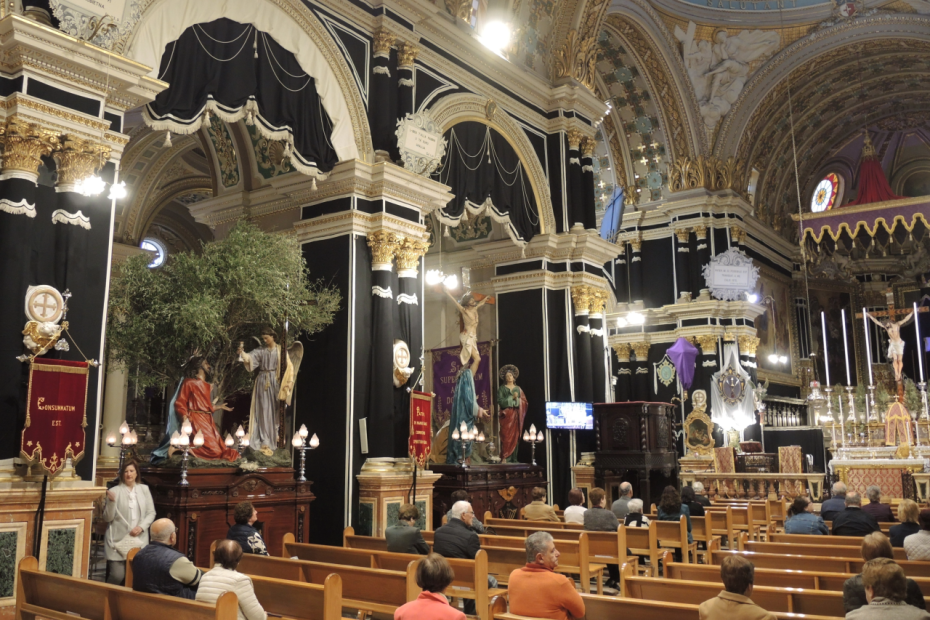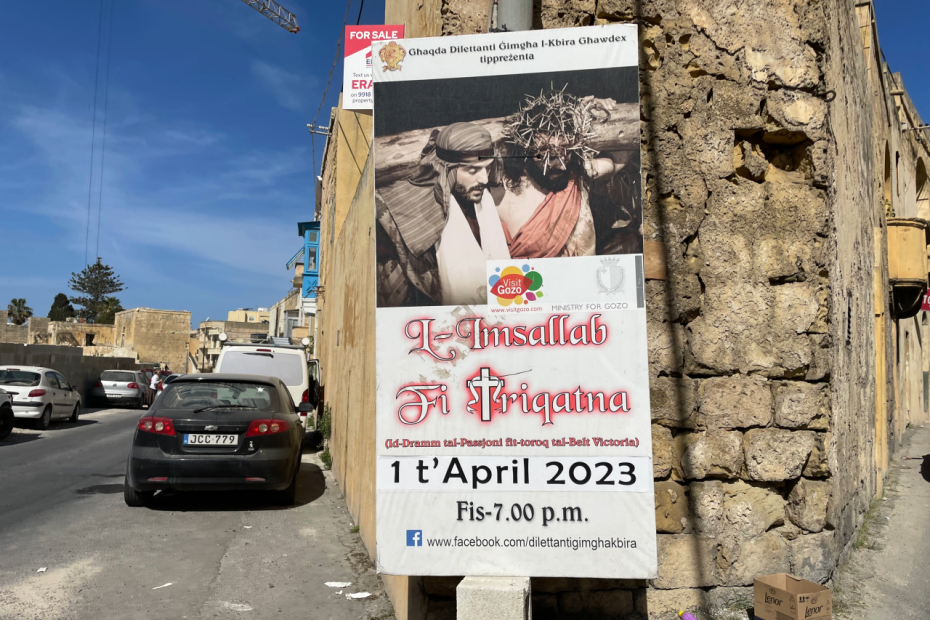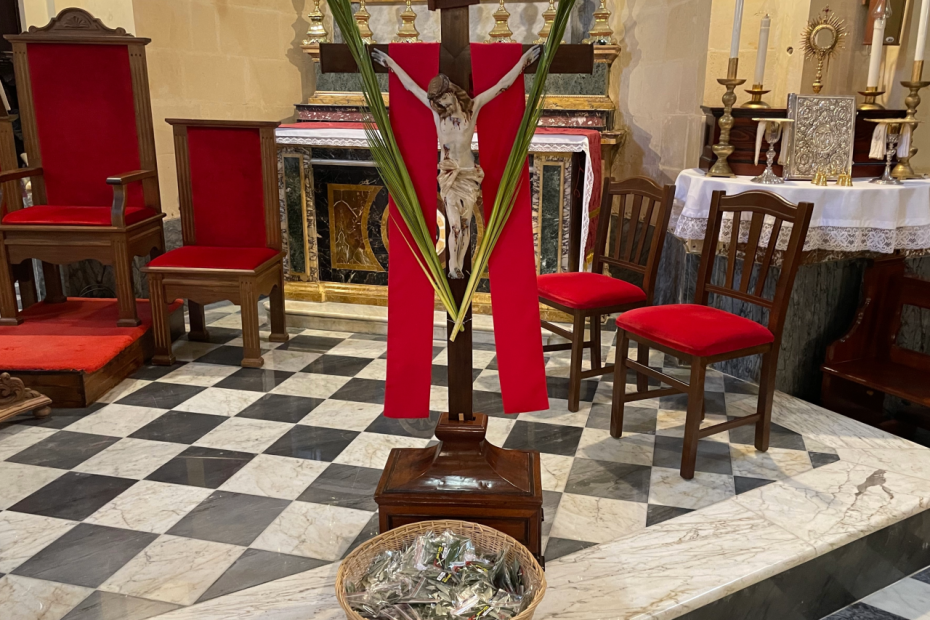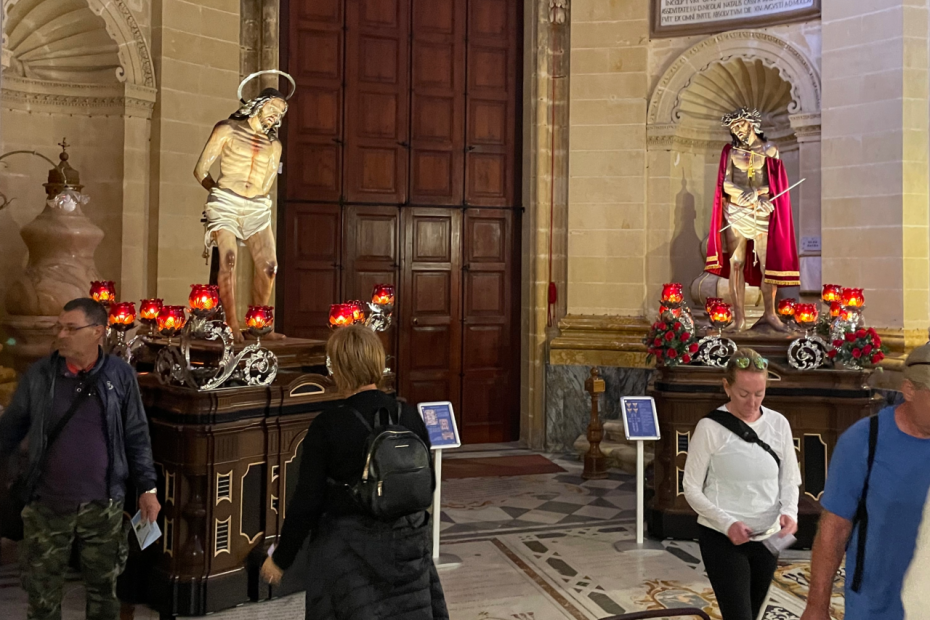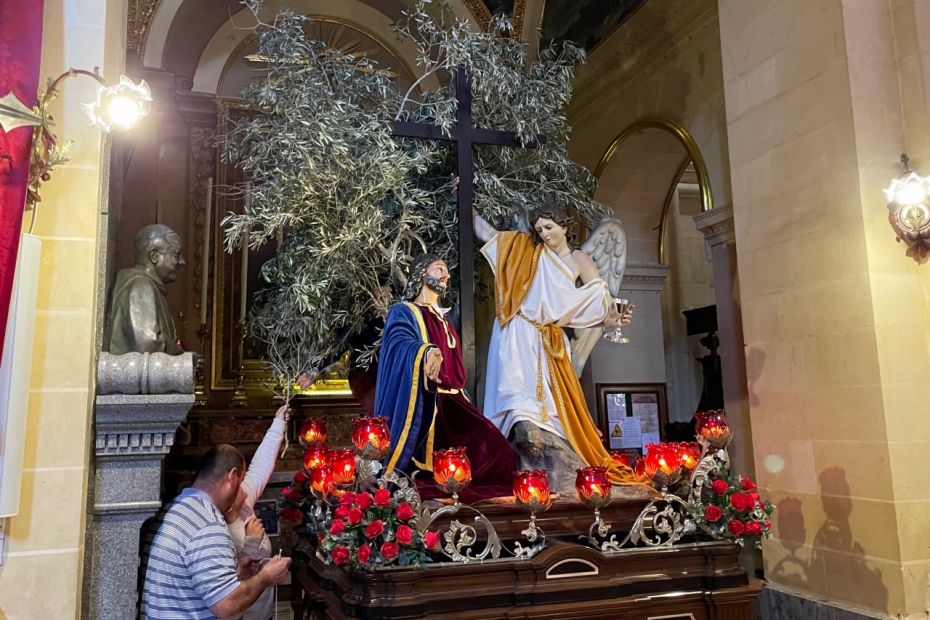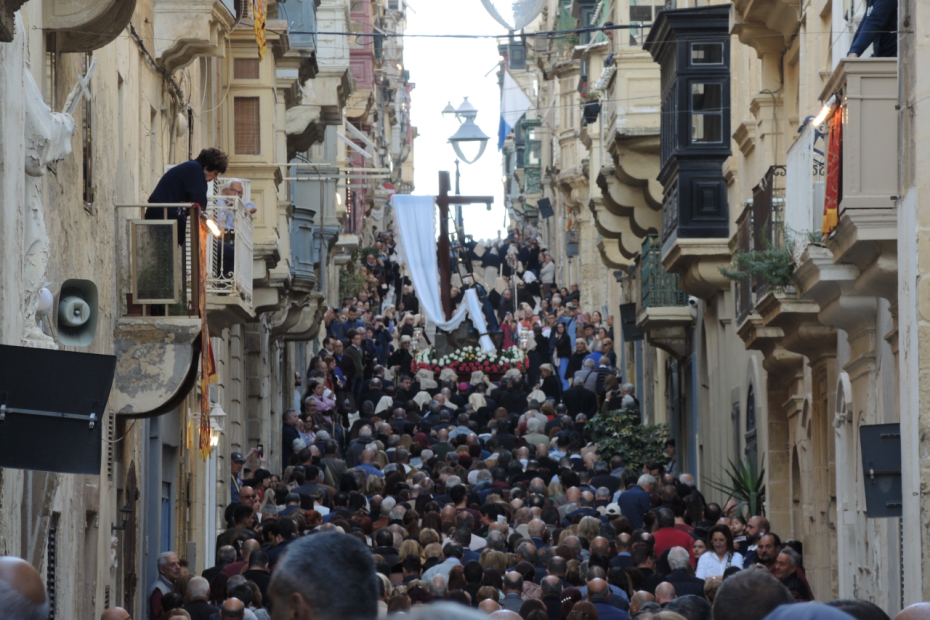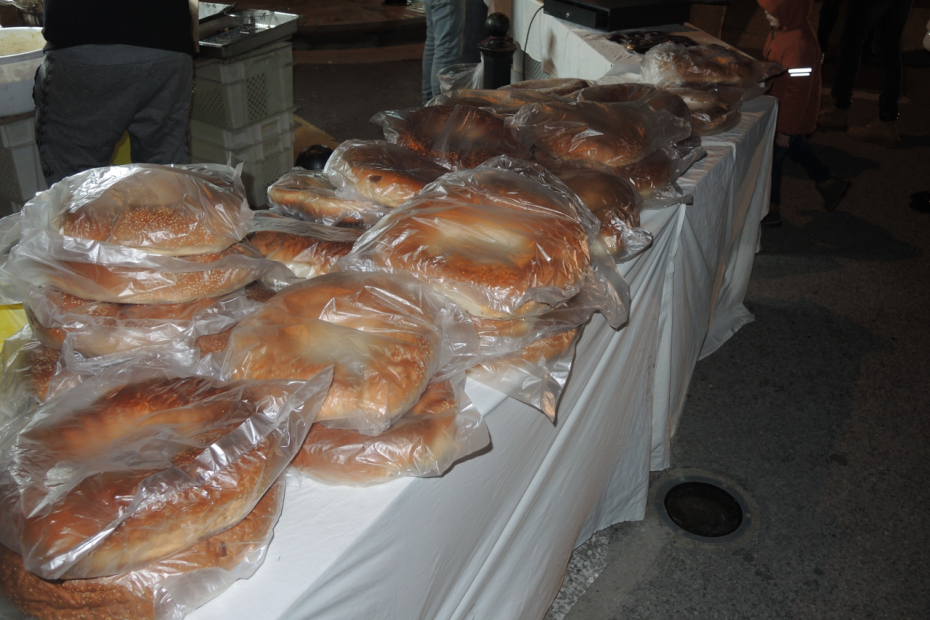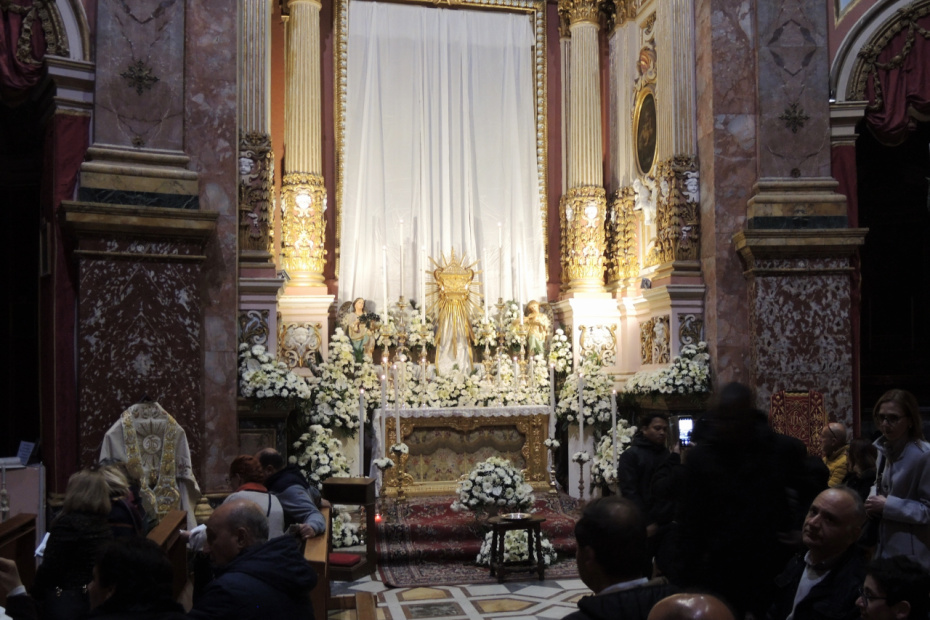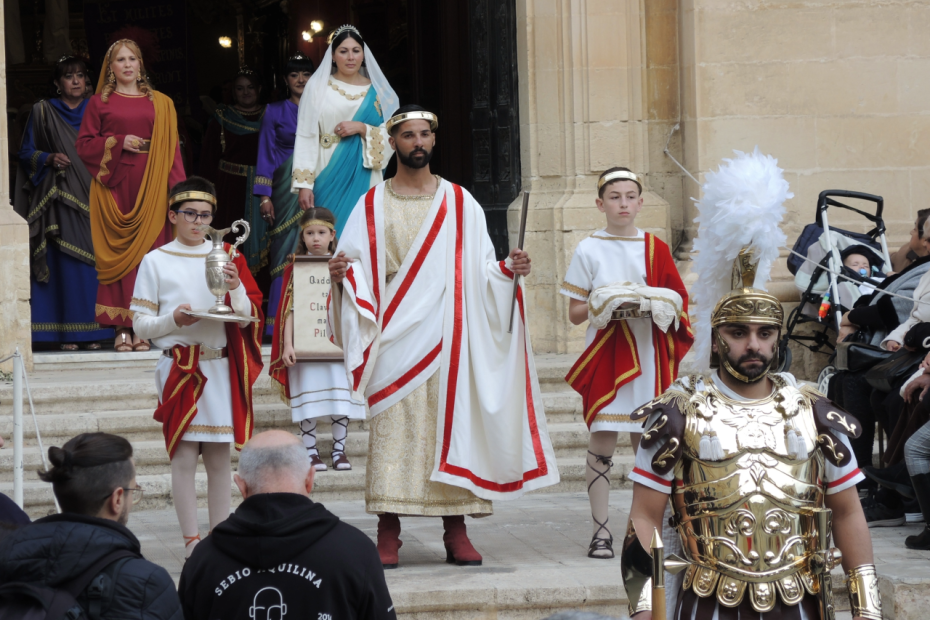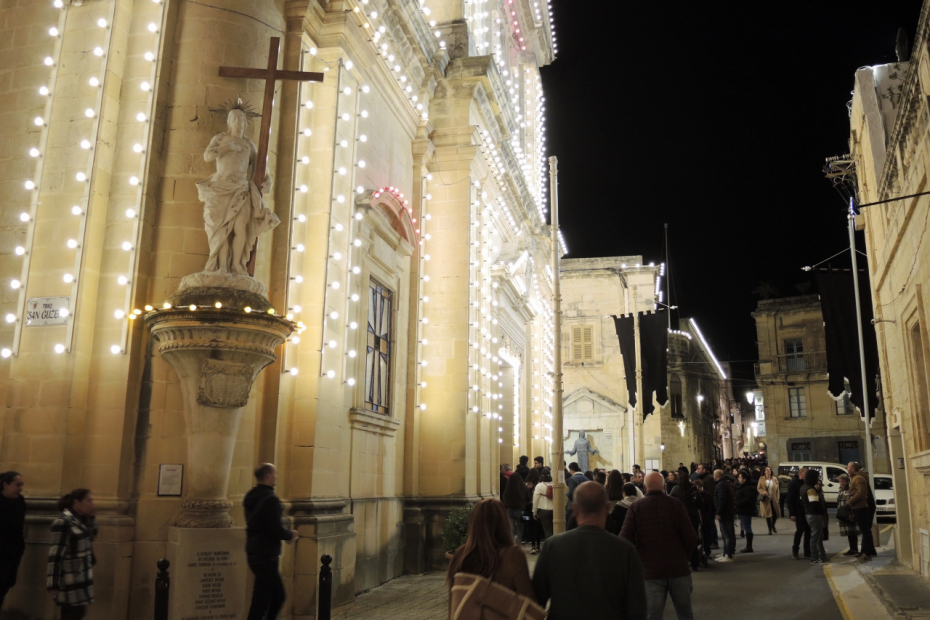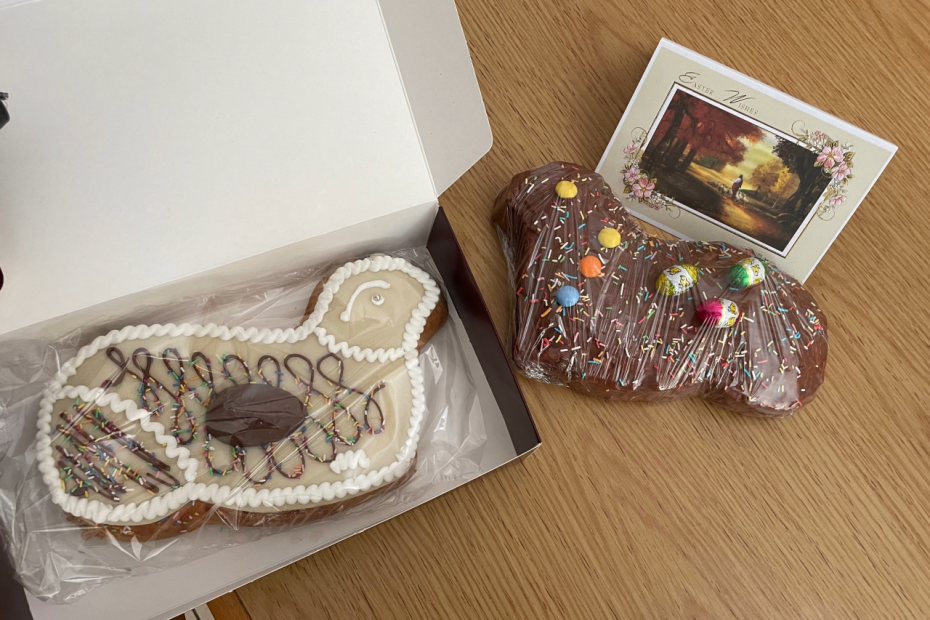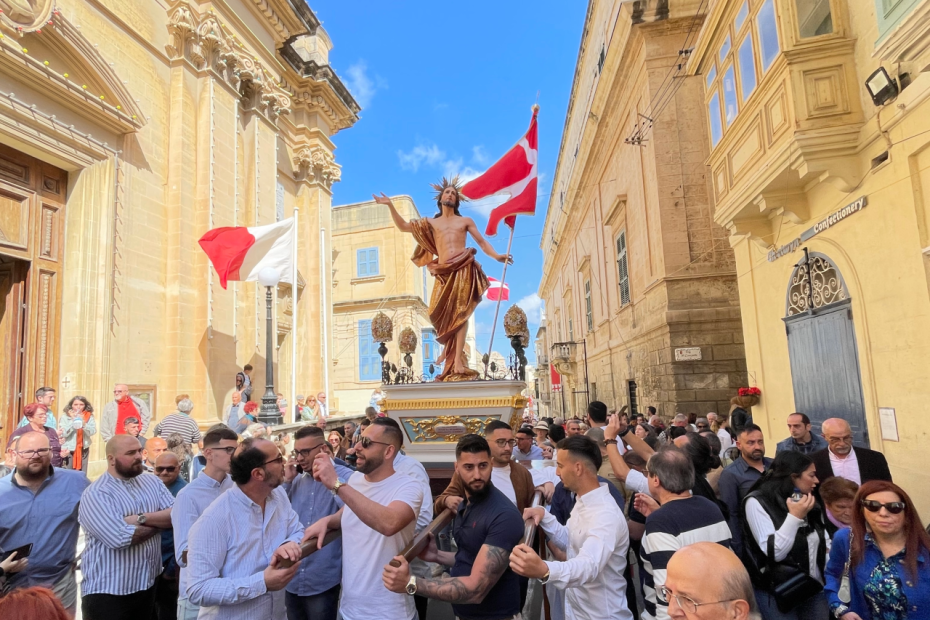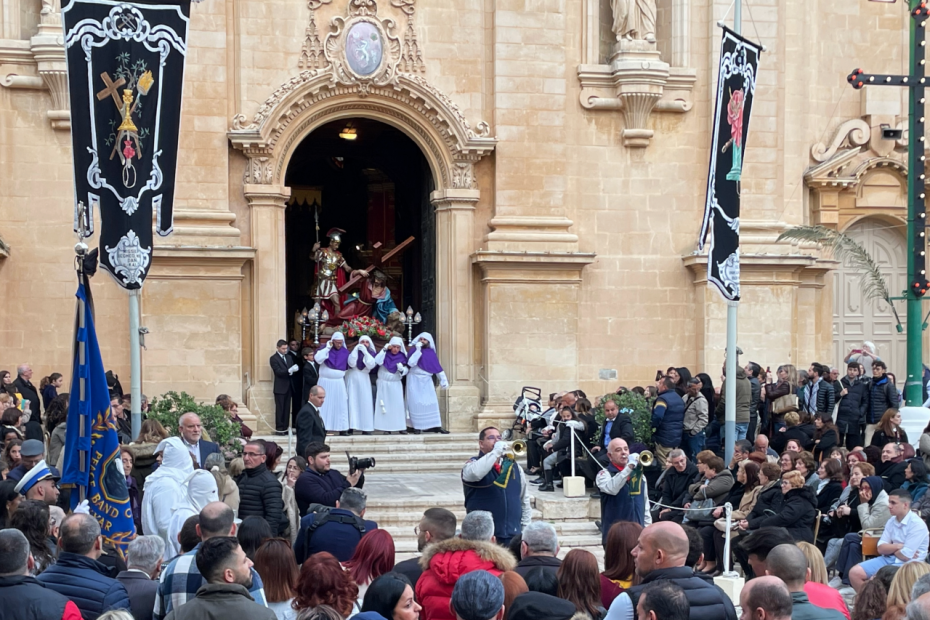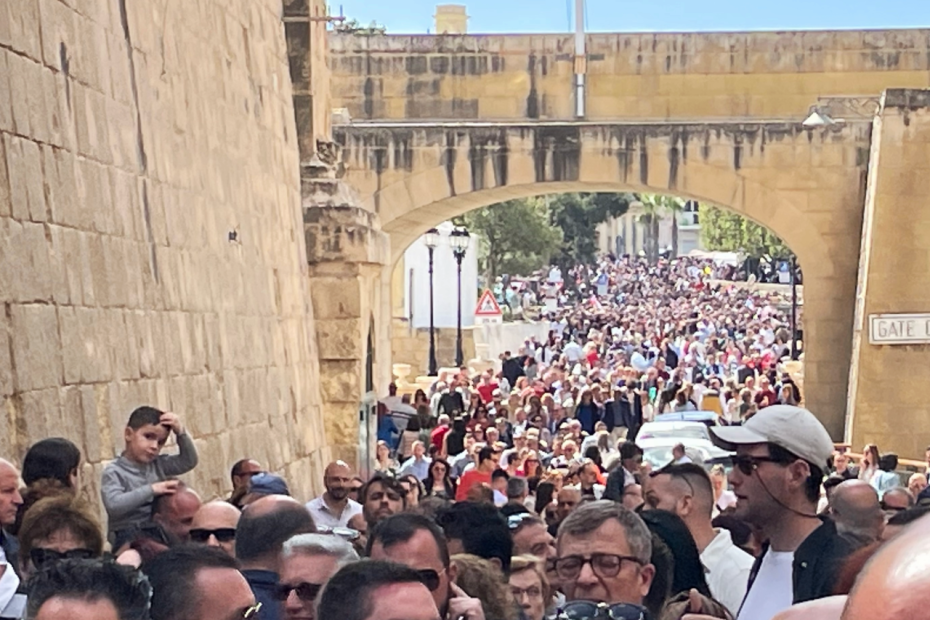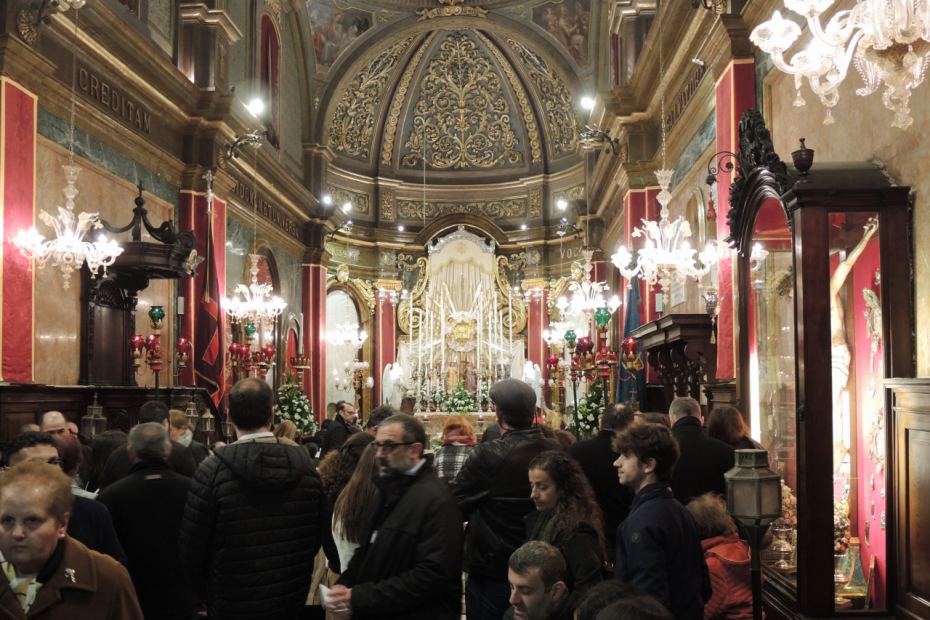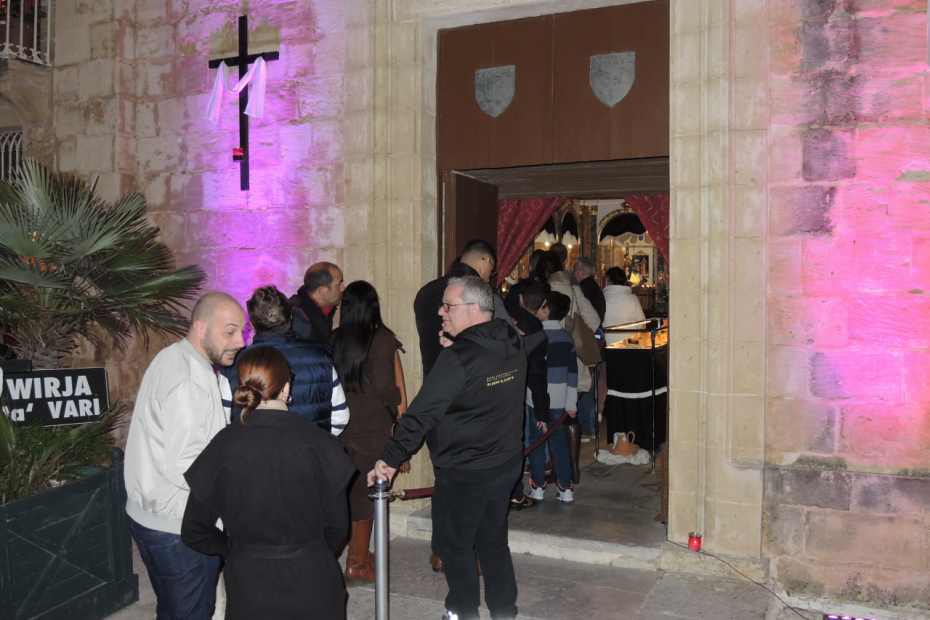Though Maltese Catholic religiosity is still very strong compared to elsewhere in Europe, some Maltese Catholics worry that practice here is in decline and too focused on two occasions: the massive summer feasts that celebrate villages’ patron saints, and Holy Week. On both occasions, large numbers of people come to the churches, and even larger crowds gather outdoors as life-size statues are brought out of the church and processed into the streets. Whether they saw this seasonality as a problem or not, all agreed that both occasions are fundamental to understanding Maltese Catholicism. A number of particularly Maltese Holy Week traditions make it an interesting story to tell.
An Early Start
While Holy Week begins in almost all of the Catholic world on Palm Sunday, in Malta, it begins in practical terms the Friday before, when the feast of Our Lady of Sorrows, Jesus’ suffering Mother, is commemorated, and her statue is brought out in solemn procession.1 Whatever the liturgical calendar may say, some Maltese describe this day as among the “most significant” days of Holy Week. Many say they relate particularly to Jesus’ mother’s pain over his suffering.2 In 2023, during this research, seemingly every parish celebrated a Mass on the feast, and at least 21 parishes on Malta and Gozo islands brought her image out into the streets in procession. In Valletta, the image of the Virgin Mary weeping at the foot of the Cross was carried slowly through most of the length of that peninsula and back as the archbishop and hundreds of people followed in solemn procession. Some walked to make a vow or as an act of thanksgiving for graces received. A small number of women even walked barefoot. En route, priests offered short reflections on the sorrowful mysteries in Mary and Jesus’ life. The crowd was generally silent.
Visual Spectacle
Decoration and imagery are important mediators of the Maltese Catholic faith and were deployed extensively to communicate to parishioners that it was during Holy Week. The fronts of Naxxar’s church and band clubs were decorated with baroque banners and huge flags on Palm Sunday. The grand church’s interior was transformed when its walls were draped in custom black silk damask panels, a tradition that was supposed to have been suppressed after Vatican II. (As the story is recounted in Naxxar, the pastor tried to suppress the custom, but at night parishioners stayed in the church and installed the black decoration anyway. Finally, the diocese relented to allow it there and in some other churches.) Inside all of Malta’s churches, elaborate altars of repose – “sepulchres,” as they are called here – were decorated on Holy Thursday with flowers and served as important sites for prayer. Along the streets, many windows displayed statues of the crucifixion or the Virgin for passersby to see. Some parishes and band clubs offered displays of small, stylized, Holy Week-themed statues belonging to local families. While the objects are devotional in form, their display was seemingly more conducive to looking than to prayer, though it is done quite respectfully and is meaningful to people as a Holy Week practice. In some settings, people had to wait in line to see them. Some parishes – most visibly on Gozo Island – also sponsor Passion plays.
Palm Sunday
Palm Sunday in Naxxar was marked by many masses and at mid-morning with a procession from the parish church to one of the village chapels and back, a spectacle of men in red and white cassock-and-surplices, giant palm branches, flags, and a priest in a biretta and red cope, all followed by a modest number of lay parishioners. The style was more baroque spectacle than an effort to recreate or imitate Jesus’ procession into Jerusalem. Lay people did not have palms to wave. Here as in other parishes, people received a small bit of olive branch, ostensibly in order to protect the islands’ few olive trees.
Holy Thursday
Holy Thursday liturgy is celebrated in the same form as in Roman Catholic churches elsewhere, with the washing of the feet. In Valletta, the largest city, attendance at the liturgy could have affirmed anyone’s fears that this is a secularizing society. The large, impressive co-cathedral, where the archbishop celebrated the feast, was about ⅔ full, and there were easily more clergy on the altar than people under 30 years old in the congregation. The streets around the cathedral, however, were full of young families that night.
Though Malta is known for the Holy Week processions that bring the Church out into the streets, another non-liturgical ritual, Holy Thursday’s seven churches visit, is equally distinctive, though not quite exclusive to Malta. That ritual brought significant crowds into churches throughout the evening. Following the Holy Thursday liturgy, many Catholics make a point of spending the evening visiting seven of the highly decorated “sepulchres,” the altars of repose set up in every church to reserve the Eucharist during the triduum. While altars of repose are common to Catholic churches globally and an element of the official liturgy of Holy Thursday, the scale of their decoration and the visits in Malta is distinctive, the experience at the co-cathedral notwithstanding.
Since each village usually has one church, travel to seven churches could be complicated, so some parishes set up seven sites within. Near the center of Malta, in the ancient, adjacent fortified hill cities of Mdina and Rabat, there are many churches, so people come there to walk between them. Inside the churches, families and groups of young adults crowded in, making Malta look hardly at all like a secularizing place. People greeted friends and chatted there, but just as often they sat in groups in front of the sepulchres praying from small, well-worn prayer booklets that they brought with them. The narrow streets of the two villages were crowded past 10:00 p.m. as people moved between churches. Street vendors sold “apostles’ bread,” ring-shaped loaves that were topped with sesame seeds or other toppings, a staple of Holy Week.
Good Friday
On Good Friday, a national holiday, life slowed down considerably. Most shops were closed, though some restaurants were open at lunch. In Naxxar, there were children’s events and prayers, and people trickled in to pray at the parish sepulchre. At 3:00 p.m., the parish held its liturgy and veneration of the Cross.
For a larger number of people here and in other parishes, the Good Friday procession that followed served as the primary form of outward religious engagement. Naxxar’s procession, a fairly typical one, was the work of hundreds of people and was a key occasion for band clubs participation. People in and around the church were busy preparing all day, and the bands and procession participants had been preparing much longer.
Instead of bells, about an hour before the procession was supposed to start, a wooden device was spun in the church’s bell tower, making a raw clapping sound to notify the village that the time for the procession was approaching. Rows of chairs were set up around the entrance. Adults and children in purchased or homemade biblical costumes, some seemingly straight out of Ben-Hur, converged at the church. Men arrived to carry the statues, a right often passed down from father to son or given to key parishioners.
Naxxar’s procession took 1.5 hours to emerge from the church. The ordering of Old Testament figures among the main processional Passion statues was difficult to grasp. The statues and their platforms are not as heavy or elaborate as the famous ones in Sevilla, Spain, and carrying them is less rigidly choreographed.3 As is its contractual right, the Peace Band, the town’s oldest band, took the first place in the order of procession. The second band club, the Victory Band, processed later. At one point a small number of men in covered penitential outfits dragged chains. Rather than move along slowly and steadily, the procession often just stopped. In a world where forms of on-screen entertainment are edited to move very quickly to capture attention, the pace was glacial. People along the route chatted in between these moments, but some just watched.
There were hundreds of people in the square and scattered along the route, a larger crowd than even the grand church could accommodate. Still, for an event that closed the streets at the village center, the crowd was modest in a village of about 15,000 people. It is difficult to know how many might watch processions on television. One Naxxar resident, asked how much the event had become a merely performative, rather than a devotional event, largely avoided the dichotomy by mentioning the value of watching, hinting that processional culture is ultimately positively understood as a spirituality of watching, not “merely” watching, as some might frame it. The same case can be made for coming to look at Holy Week’s statue displays and passion plays.
Holy Saturday was a quieter day, but a group of men and women put tremendous effort into preparing and cleaning the church.
Easter
Naxxar’s parish celebrated the Easter Vigil with about 200 people in attendance, moving from darkness broken first by the Easter fire, through the readings that recounted salvation history. The black cloth on the walls had been removed to show the full glory of the space, fitting for Easter.
Easter Sunday is marked across the Maltese landscape by enormous white flags with red crosses, by the peeling of bells, and in many cases by processions. In Naxxar, the streets were quiet and the five Masses were moderately well-attended. In the afternoon, the parish celebrated Mass again followed by a procession of a statue of the risen Christ, accompanied by the Peace band. Many people visited their deceased loved ones’ tombs on Easter as well, and flower sellers outside the cemeteries seemed to do good business. In homes, apostles’ bread gave way to figolla, a Maltese frosted cake-sized sweet shaped like a heart, lamb, egg, or some other symbol of Easter. Some said that lamb was a popular dish for the day, but others said that the meal choice was open.
A few parishes celebrated that procession in an even more full-throated way. On the steep hills of Birgu (aka Vittoriosa) above the main harbor, St. Lawrence parish marked the day, as is its tradition, by running a risen Christ statue through the streets on the shoulders of a dozen or so young men. Running might seem at first glance inapproprite at a procession, but in Birgu it manifested the joy of the resurrection. The run, lasting many hours, drew huge crowds. The pastor walked along the route blessing and chatting with people before the statue was run from one designated site to the next. The first and most ebullient stop was to the village band club, centrally located in the plaza. Other stops were at village chapels, where prayers were recited and the young men rested before they dashed as fast as they could to the next stop. The crowds in the streets were joyous, and Easter really felt like a radically different occasion after Holy Week.
Holy Week in a Changing Malta
In a country where Catholic practice is said to be transforming from intensive, year-round commitment to more seasonal practice, Holy Week is consistently described as a religious touchstone of Maltese Catholic life, a high point in that cycle of engagement. It could seem as if the focus of so much of the country’s religious energy on Holy Week, from our Lady of Sorrows to Good Friday, implies that Maltese culture especially valorizes suffering, but lay Maltans argued that the valorization of suffering is not a key cultural value, though it could once have been. If anything, they said, whatever they might have briefly encountered about Jesus’ or Mary’s suffering was often forgotten in a society more focused on prosperity. (Any supposed cultural focus on suffering is certainly countered by the other seasonal highlight of the year, the parish feasts).
Holy Week in Malta is a time when a cultural tension between forms of religiosity–one primarily private and interior, the other more public, performative, and embodied in objects like statues or processing people accompanying them–is readily apparent. Some interviewees saw the public events as primary, though perhaps diminishing, ways of practicing faith in Malta. Some Catholics, including clergy, worried that the processions did not take devotees in deeply enough to the faith, but substituted spectacle for deep experience.4 Other, mostly young people reported that they did not feel the need for those forms of public practice to support their faith, and preferred other ways of relating to God, mostly in private prayer. At some of the events above, the number of people in attendance was modest for a high point in the liturgical calendar; at others, as noted, attendance was robust and vibrant.
Some interviewees lamented that the government, which advertises Holy Week celebrations to draw tourists, is commodifying a sacred commemoration. Still, there was no evidence of other non-Maltese at the procession in Naxxar.5 Asked if the public events had become primarily performative events that were thin on depth of devotion–one could easily, for example, notice that many viewers on the street seemed most engaged when they saw a friend or family member process by in costume or in the band–most interviewees said that there was something religiously genuine going on in the processions. They were not just pageants but they meant something to the people who participated in them. They were catechetical to the young, and many workmen and others worked hard as an act of devotion to prepare for the day.
Authentic as processional devotion was said to be, interviewees of all ages made clear that something had changed. On Malta Island, Catholics often said that on neighboring Gozo Island, Holy Week was still celebrated with the greater seriousness that Malta residents associate with the past.
- 1Elsewhere in the Western Catholic Church, the feast is celebrated on Sept. 15.
- 2The articles here are based on interviews and participation in Malta and Gozo during Holy Week 2023 and at a June 2023 parish feast. While centered in the village of Naxxar, the week provided opportunities to visit many churches, as indicated below.
- 3The differences from Sevilla are manifold, including that each Maltese procession takes place in its own village rather than converging at a main spot in the city. Malta’s are also less formalized and disciplined than Sevilla’s.
- 4The research for these articles provided fewer opportunities than hoped to witness family practice during Holy Week, but a number of interviewees described it as diminished and mentioned the elements listed above. The changed pace of the week, with stores closed or family visits, seemed to be a primary shift in families’ lives.
- 5Some parishes, including Naxxar, lined up seats that could be rented for a fee in front of the church as a fundraiser. At least in that parish, though, there was no evidence that these were taken by non-Maltese. There were also non-native inhabitants of Malta but no obvious tourists.
